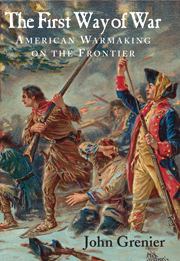Book contents
- Frontmatter
- Contents
- List of Figures and Maps
- Preface
- Acknowledgments
- List of Abbreviations
- Introduction
- 1 The First Way of War's Origins in Colonial America
- 2 The First Way of War in the North American Wars of King George II, 1739–1755
- 3 Continental and British Petite Guerre, circa 1750
- 4 The First Way of War in the Seven Years' War, 1754–1763
- 5 The First Way of War in the Era of the American Revolution
- 6 The First Way of War in the 1790s
- 7 The First Way of War and the Final Conquest of the Transappalachian West
- Epilogue
- Index
4 - The First Way of War in the Seven Years' War, 1754–1763
Published online by Cambridge University Press: 05 June 2012
- Frontmatter
- Contents
- List of Figures and Maps
- Preface
- Acknowledgments
- List of Abbreviations
- Introduction
- 1 The First Way of War's Origins in Colonial America
- 2 The First Way of War in the North American Wars of King George II, 1739–1755
- 3 Continental and British Petite Guerre, circa 1750
- 4 The First Way of War in the Seven Years' War, 1754–1763
- 5 The First Way of War in the Era of the American Revolution
- 6 The First Way of War in the 1790s
- 7 The First Way of War and the Final Conquest of the Transappalachian West
- Epilogue
- Index
Summary
At Crown Point, on September 13, 1759, Major Robert Rogers received orders from Major General Jeffery Amherst to lead a force of hand-picked American rangers, British volunteers, and Stockbridge Indian scouts against the Abenaki village at St. François in the St. Lawrence Valley, 150 miles to the north. “Remember the barbarities that have been committed by the enemy's Indian scoundrels on every occasion where they had an opportunity of showing their infamous cruelties on the King's subjects, which they have done without mercy,” Amherst reminded Rogers. “Take your revenge,” he continued, “but don't forget that though those villains have dastardly and promiscuously murdered the women and children of all ages, it is my orders that no women or children are killed or hurt.”
Rogers ignored Amherst's prohibition on the killing of noncombatants. After a grueling march of 22 days, Rogers and 142 raiders arrived outside St. François. When he reconnoitered the village, Rogers discovered hundreds of scalp-festooned poles flying from lodges and the Abenakis celebrating the successes of a recent scalp-hunting foray on the American frontier. Rogers determined that vengeance would be the rangers'. He returned to his trail-weary troops, granted them a few hours to rest, and then deployed them for a predawn attack on the village. “At half an hour before sun-rise,” he recalled, “I surprised the town when they [the Abenakis] were all fast asleep.”
- Type
- Chapter
- Information
- The First Way of WarAmerican War Making on the Frontier, 1607–1814, pp. 115 - 145Publisher: Cambridge University PressPrint publication year: 2005



